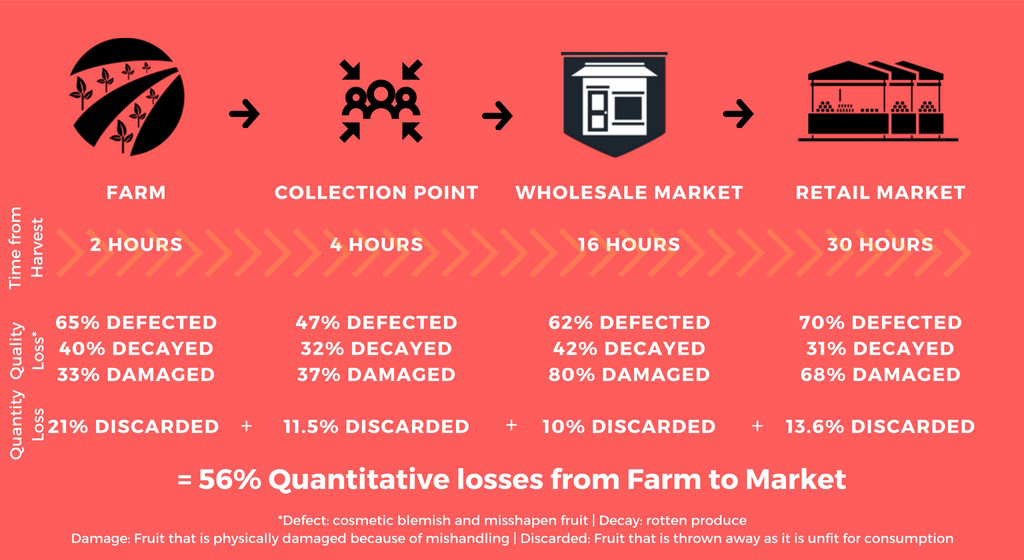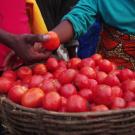This report and policy brief were created by the Horticulture Innovation Lab's project, Reducing postharvest losses in Rwanda. The project aims to understand and identify the most efficient ways to reduce postharvest losses in Rwanda. Through postharvest innovations and interventions, this project works to help farmers and agribusiness enterprises gain better return on investments by adopting appropriate technology and reducing postharvest losses.

Summary of tomato postharvest losses in Rwanda
Tomatoes are a widely produced and consumed horticultural crop in Rwanda with consumption on the rise. Rwanda is a net importer of tomato. The production is seasonal and the crop is highly perishable. Tomatoes have been identified as a priority crop for the Reducing Postharvest Losses in Rwanda project, as previous studies have noted high losses (WFLO 2010).
To understand the postharvest losses in the tomato value chain, the project conducted three types of analysis – Value Chain Analysis, Commodity Systems Assessment Methodology and Environmental Lifecycle Analysis.
The primary finding from measuring losses along the value chain was that damage and defects were extremely high, which resulted in a lower sales price and produce being discarded. Mechanical damage progressively increased from the farm (33%) to the retail market (68%). Overall, 21 percent was discarded at the farm level, 11.5 percent was discarded at the collection point, 10 percent was discarded at the wholesale market and 13.6 percent was discarded at the retail market leading to 56 percent of tomatoes being discarded in their journey from farm to market.
Tomato sales and distribution is a fragmented system and large players are rewarded. Traders and wholesalers play an integral part in the tomato industry, moving the crop from the farm to the markets. The market rewards big players such as large farmers who have wholesalers and retailers buying directly from their farm. This allows them to command the best prices due to volume and quality. Smaller players are unable to attract the interest of wholesalers or large traders and have to sell at the village markets. For smallholder farmers increasing quality and quantity and organizing themselves for better bargaining powers, would be key to success.
Tomatoes have a wide range of potential processed and value-added products, including sauces, jams, ketchups, paste, and dried. The development of a vibrant processing industry would help develop the industry as a whole, by increasing the number of tomato farmers (and thereby its importance in the economy) as well as providing steady, all-season demand and the ability to absorb on-season overproduction, thereby reducing losses.
Improved postharvest handling has a strong role to play in improving saleable volumes by increasing both the quantity and quality of tomatoes. Field work estimates from the Commodity Systems Assessment Methodology show that all actors along the chain are suffering losses as tomatoes have defects, are decayed and physically damaged. Improving postharvest handling and storage practices will reward each actor along the value chain by increasing the quantity and quality of tomatoes.
Postharvest losses is a complex problem and an integrated solution is needed to mitigate losses across the value chain. To reduce postharvest losses, farmers and traders need to be educated on harvesting practices and postharvest handling and storage. Entrepreneurs are needed to provide postharvest handling and storage equipment including cooling technology. Transportation solutions are also required, as tomatoes are damaged further as a result of being overloaded onto trucks using poor packaging.
Postharvest losses from tomatoes does not only lead to the loss of saleable and consumable volumes but also translates to more land, water, fertilizers, chemicals and other inputs. Per tonne of tomatoes produced, 21 kg of fertilizers are lost due to postharvest losses. Tomato losses also account for 86 cubic meters of water per tonne of tomatoes. This number represents the amount of water consumed to produce the amount of tomatoes that are lost per tonne of tomatoes delivered to the market. Reducing postharvest losses is key to reducing the environmental impact of agriculture and conserving limited resources
Key findings related to tomato postharvest handling
-
Availability of quality affordable seed on the market has been a limitation to the farmers. The farmers are using regenerated seeds, which at times are up to 3rd generation seed. This greatly lowers seed productivity as the seeds realize less resistance to pests and diseases.
-
Tomatoes are harvested red ripe and soft, with little shelf life remaining.
-
Tomato packing and repacking occurs several times, which greatly reduces the quality at farm level. Handling was observed to occur up to 27 times on one farm before transport to the wholesale market leading to reduction in quality by the time of arrival to the consumer.
-
Proper storage after harvest at the farm is one of the major limitations.
-
Lead time between harvest at farm level to customer is approximately 1 day, leaving approximately 2 to 3 days of shelf life. If any delays occur, this leads to additional postharvest losses.
-
Tomatoes are packed and transported in large baskets leading to various losses along the chain.
-
Trucks are overloaded for the transport of produce for long distances.
-
There are no cold chains or cool storage facilities for tomatoes.
-
Farmer cooperatives are not properly organized, which has led to lack of bargaining power for selling their produce to traders.
Postharvest report methodology
To understand postharvest losses in the tomato value chain, the project conducted three types of analysis: Value Chain Analysis, Commodity Systems Assessment Methodology (CSAM) and Environmental Lifecycle Analysis.
Postharvest losses were measured using a modified Commodity Systems Assessment Methodology (CSAM). The CSAM is a methodology for describing and evaluating the planning, production, postharvest handling and marketing of agricultural commodities. The modified CSAM includes interviews of stakeholders, observations of handling practices, and direct measurements of quality and quantity losses throughout the value chain.
A life cycle assessment (LCA) was also employed. LCA is a standardized procedure used to determine the environmental impacts of products services or goods. Primary data was collected from growers and areas within the postharvest supply chain through interviews and surveys.
A value chain analysis was completed in order to identify constraints. The analysis was completed using interviews with key actors, site visits, and a literature review.

